Scaling Video Uploads for Growth at Newsflare
Product Architecture Thinking
Segmented Experience Design
Dual-Track Leadership
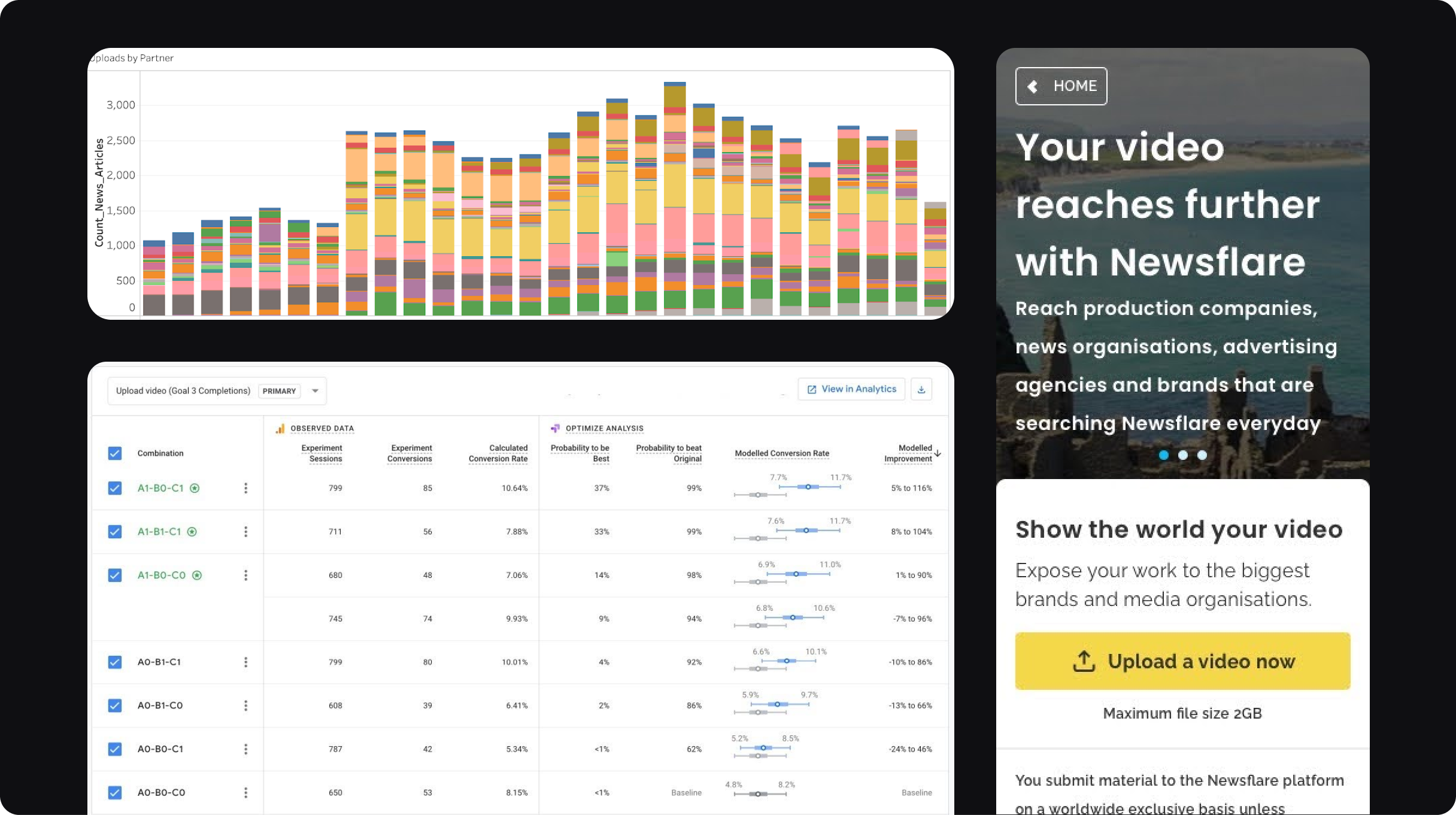
Overview
I redesigned Newsflare’s video upload journey across both manual and automated contributors. This included launching a fully automated ingestion architecture for partners via MRSS, and a redesigned mobile-first upload flow for Chasers. The result: scale without added headcount, a modernised architecture, and a supply strategy that redefined the company’s growth direction.
Involvement
Project Lead
~2 month duration (Oct - Nov ‘24)
Figjam, Figjam, Linear
Impact
+50%
A more modern and professional first impression for prospects, helping Intruder stand out in a crowded cybersecurity market.
+200%
Increase in uploads from Content Partners after adopting the newly built pipeline.
0 → 1 Launch
A tokenised component library and visual guidelines enabled quicker marketing iterations and reduced bottlenecks for designers and marketers, making brand execution more efficient.
Challenge
Newsflare is a video marketplace connecting public filmers to media buyers across news, entertainment, and advertising. But while demand was strong, the upload experience couldn’t scale—especially for high-value contributors like Content Partners and professional filmers (Chasers).
Uploads were slow, fragmented, and manual. As both Design Lead and Product Manager, I was tasked with reimagining this journey from the ground up to scale contribution, retain high-value users, and future-proof the upload experience.
Problem
- Fragmented architecture: Multiple upload flows with duplicated tech debt made iteration nearly impossible.
- Mobile-first audience, desktop-first design: 90% of uploads came from mobile, yet the experience was not optimised.
- Zero feedback loops: Filmers described uploading as “throwing videos into a black hole.”
- Lack of product-market fit clarity: Newsflare had never defined core filmer segments or how their needs differed.

Practically speaking there were five upload processes when the work began. These generated an incredible amount of inconsistency and tech-debt.
Goals
- Scale video ingestion from both manual and automated sources
- Prioritise high-value filmer types
- Consolidate and modernise the upload journey
- Build a flexible architecture that could adapt across verticals and ingestion points
Research & Segmentation
We began by speaking directly with our users—through interviews, surveys, and passive data collection.

I started recording sentiments of users regularly accessing the platform in addition to a review of platform analytics.

I also talked to a wide range of different customer types in group settings and one-on-one.
Doing this we identified four filmer archetypes:
Filmer Archetype
Primary Need
Contribution Volume
Chancers
Opportunistic earnings
Low
Chasers
Repeatable income
High
Creators
Audience and platform growth
Moderate
Content Partners
Sale and syndication
Very High
We then validated product-market fit across each segment using the 40% PMF threshold. Chasers and Content Partners stood out as disproportionately valuable.
Outside of Content-Partners ‘Chasers’ were disproportionately valuable to Newsflare securing a defensible base of organic saleable video.

We then summarised comments from key customers segments who responded positively to PMF surveys we sent out to the user base.

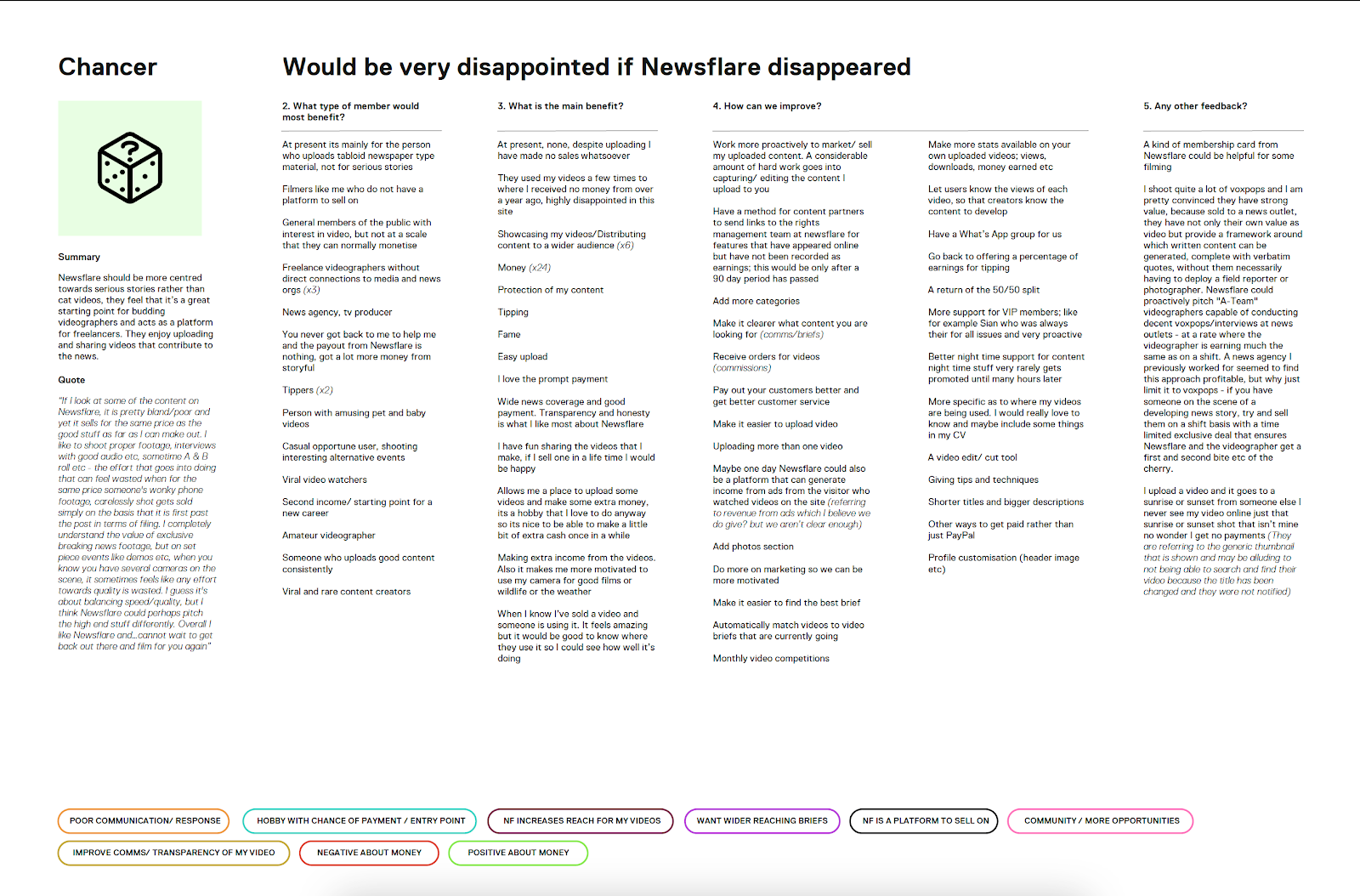

Approach
I led the end-to-end redesign of the upload experience for both Chasers (manual) and Content Partners (automated), two tracks running in parallel, but each requiring a fundamentally different strategy.
Solution 1: MRSS Uploads for Content Partners
Challenge
Partners wanted to upload thousands of videos but lacked the time or UI to do so.
Iteration
Initial UI prototypes for scale upload failed. We went back to user interviews—and discovered many partners already used MRSS feeds internally. This was the breakthrough.

A very early prototype design, not finalised.
Implementation
I designed and launched a new ingestion architecture that scraped MRSS feeds and imported video libraries directly into Newsflare. I prototyped it alongside a single partner, then scaled it across our supply pipeline.

The initial MRSS Feed from the Content Partner I worked with to prototype the upload feed.
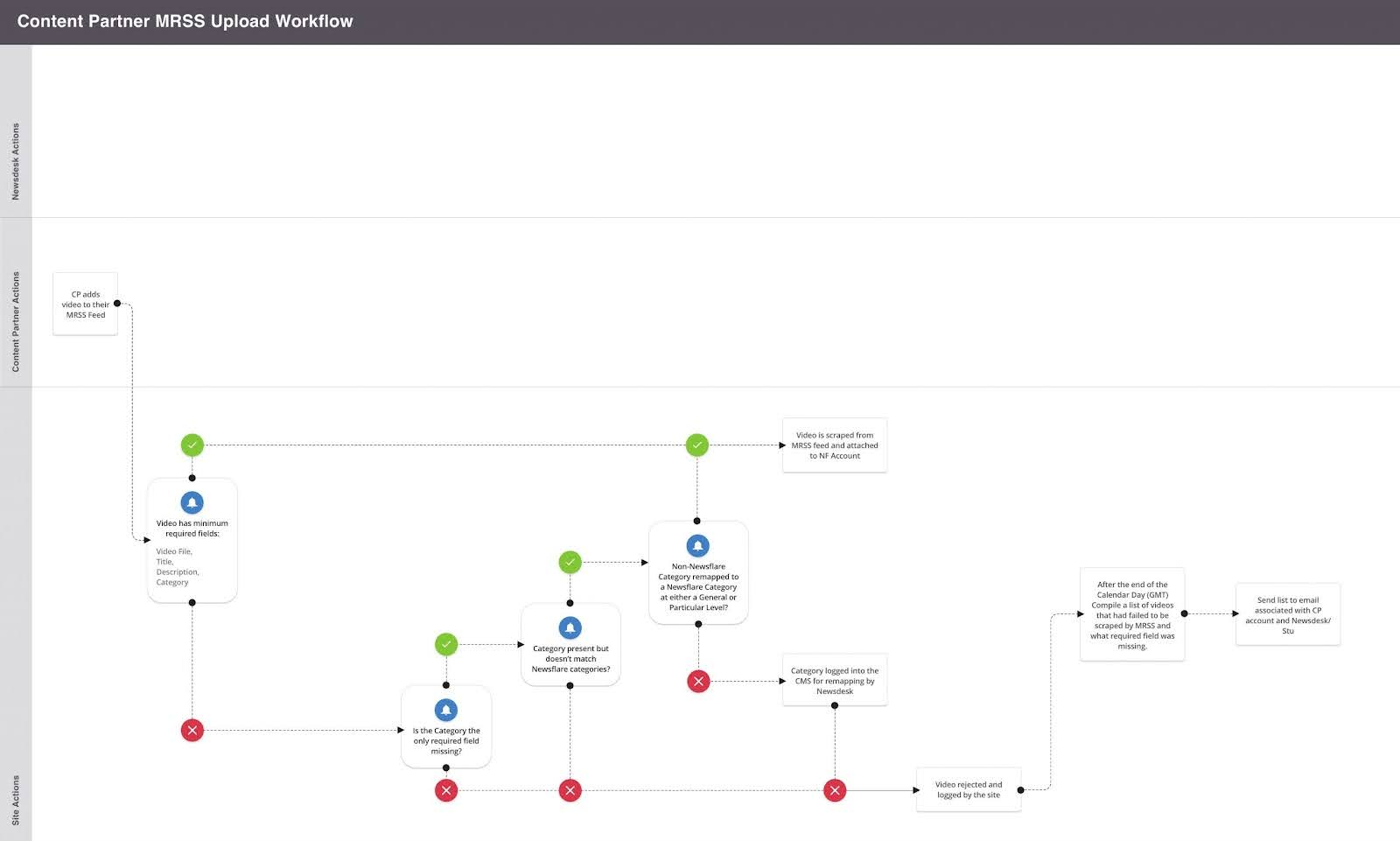
The first, very basic, flow I sketched out for the MRSS Feed.

The jump in uploads reflects the impact the MRSS Feed release had on video intake from Content Partners.
Impact
- Order-of-magnitude scale: Enabled bulk ingestion without human intervention
- Became the cornerstone of supply: Adopted as the primary supply strategy for the following year
- New partners onboarded: Lowered friction dramatically, opening doors to contributors previously deterred by manual uploads
- Industry edge: No other competitor offered this kind of automated syndication feed at the time
Solution 2: Manual Upload Redesign for Chasers
Challenge
Chasers contributed ~35% of saleable video but were hampered by friction, repetition, and lack of feedback.
Tests & Experiments
I ran multiple iterative experiments to reduce friction and increase clarity, including:
- Strength indicators based on title quality
- Auto-tagging based on metadata
- Input presets for mobile
- Reusable fields across uploads
- Language simplification for EASL speakers
This multivariate test produced several variants that outperformed the control, revealing the levers that mattered most and shaping the next round of experiments.
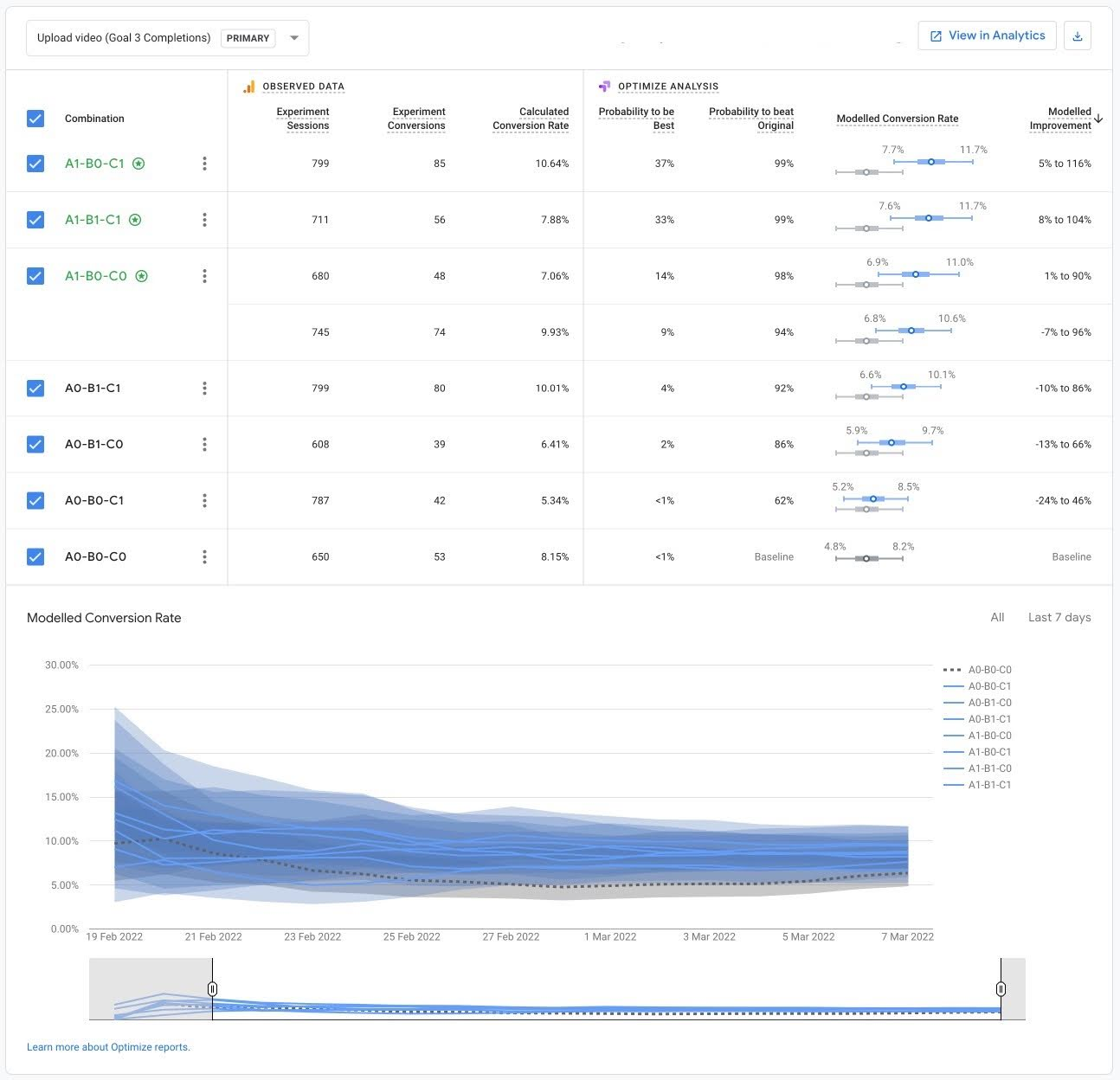
We also redesigned the page mobile-first, chunking inputs, removing redundant features, and creating pre-upload and post-upload experiences to bookend the journey with clarity and encouragement.

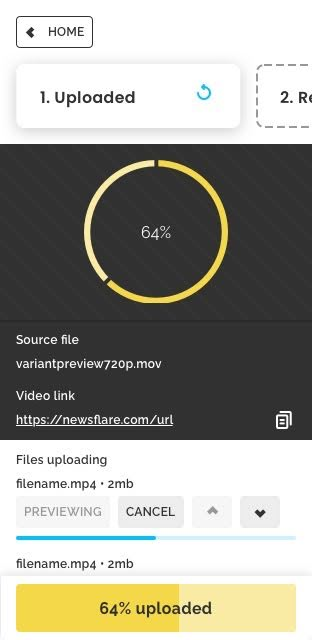

Flow Mapping
Mapped the entire upload and post-processing journey to consolidate all entry points and reduce duplication. Pushed toward a single injectable upload instance across the platform, modular, flexible, and maintainable.
Revised default upload flow
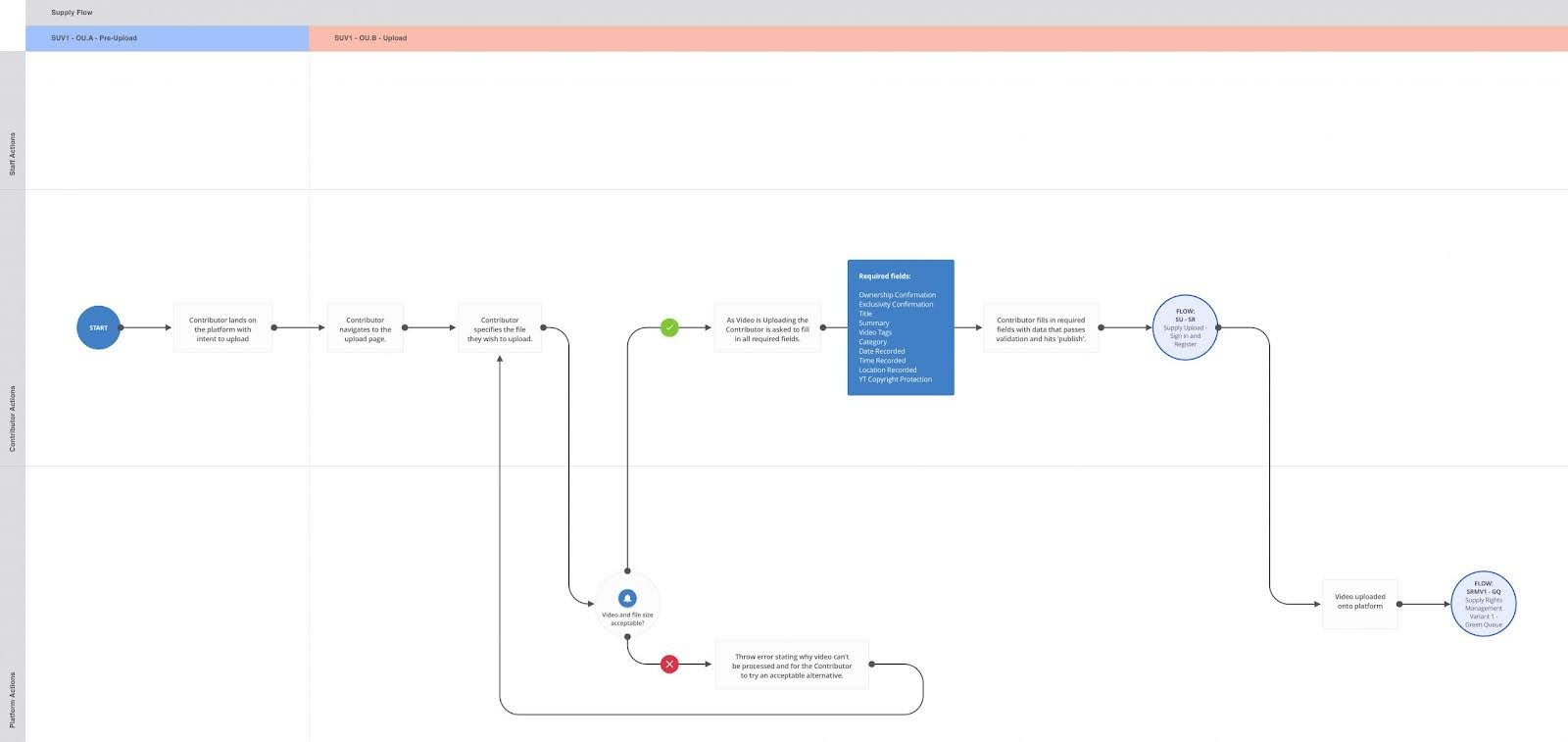
Revised consent form minority flow

Consolidated post-upload flow

Impact
50% increase in monthly uploads from Chasers (Avg. 2.4 → 3.6)
Consistent 8+/10 CSAT scores in usability testing
Unified upload architecture reduced technical overhead and enabled faster iteration
Future Direction
During testing, we uncovered a critical barrier: Chasers filmed more than they uploaded due to repetitive metadata entry on mobile.
To solve this, I prototyped a one-to-many model: allowing multiple videos to share a single metadata set. This experiment led to a 7x increase in uploads during testing.
This unlocked multiple future growth avenues:
- Publishing spread across sessions, apps, and devices
- Automation and bots to handle content submissions on 3rd party apps popular with key filmer segments like Telegram.
- Varied metadata requirements based on category/location
- Abandoned upload recovery (similar to e-comm cart recovery)
- Timeline-style uploads for multiple videos depicting a single event.
What I learned
- Product architecture is product strategy: How you structure ingestion shapes your entire value chain
- Scaling supply requires segmentation: Treating all uploaders the same was holding Newsflare back
- Automating value creation isn’t a nice-to-have, it’s table stakes when operating a media marketplace at scale
Interested in discussing this project?
Scaling Video Uploads for Growth at Newsflare
Product Architecture Thinking
Segmented Experience Design
Dual-Track Leadership

Overview
I redesigned Newsflare’s video upload journey across both manual and automated contributors. This included launching a fully automated ingestion architecture for partners via MRSS, and a redesigned mobile-first upload flow for Chasers. The result: scale without added headcount, a modernised architecture, and a supply strategy that redefined the company’s growth direction.
Involvement
Project Lead
~2 month duration (Oct - Nov ‘24)
Figjam, Figjam, Linear
Impact
+50%
A more modern and professional first impression for prospects, helping Intruder stand out in a crowded cybersecurity market.
+200%
Increase in uploads from Content Partners after adopting the newly built pipeline.
0 → 1 Launch
A tokenised component library and visual guidelines enabled quicker marketing iterations and reduced bottlenecks for designers and marketers, making brand execution more efficient.
Challenge
Newsflare is a video marketplace connecting public filmers to media buyers across news, entertainment, and advertising. But while demand was strong, the upload experience couldn’t scale—especially for high-value contributors like Content Partners and professional filmers (Chasers).
Uploads were slow, fragmented, and manual. As both Design Lead and Product Manager, I was tasked with reimagining this journey from the ground up to scale contribution, retain high-value users, and future-proof the upload experience.
Problem
- Fragmented architecture: Multiple upload flows with duplicated tech debt made iteration nearly impossible.
- Mobile-first audience, desktop-first design: 90% of uploads came from mobile, yet the experience was not optimised.
- Zero feedback loops: Filmers described uploading as “throwing videos into a black hole.”
- Lack of product-market fit clarity: Newsflare had never defined core filmer segments or how their needs differed.

Practically speaking there were five upload processes when the work began. These generated an incredible amount of inconsistency and tech-debt.
Goals
- Scale video ingestion from both manual and automated sources
- Prioritise high-value filmer types
- Consolidate and modernise the upload journey
- Build a flexible architecture that could adapt across verticals and ingestion points
Research & Segmentation
We began by speaking directly with our users—through interviews, surveys, and passive data collection.

I started recording sentiments of users regularly accessing the platform in addition to a review of platform analytics.

I also talked to a wide range of different customer types in group settings and one-on-one.
Doing this we identified four filmer archetypes:
Filmer Archetype
Primary Need
Contribution Volume
Chancers
Opportunistic earnings
Low
Chasers
Repeatable income
High
Creators
Audience and platform growth
Moderate
Content Partners
Sale and syndication
Very High
We then validated product-market fit across each segment using the 40% PMF threshold. Chasers and Content Partners stood out as disproportionately valuable.
Outside of Content-Partners ‘Chasers’ were disproportionately valuable to Newsflare securing a defensible base of organic saleable video.

We then summarised comments from key customers segments who responded positively to PMF surveys we sent out to the user base.



Approach
I led the end-to-end redesign of the upload experience for both Chasers (manual) and Content Partners (automated), two tracks running in parallel, but each requiring a fundamentally different strategy.
Solution 1: MRSS Uploads for Content Partners
Challenge
Partners wanted to upload thousands of videos but lacked the time or UI to do so.
Iteration
Initial UI prototypes for scale upload failed. We went back to user interviews—and discovered many partners already used MRSS feeds internally. This was the breakthrough.

A very early prototype design, not finalised.
Implementation
I designed and launched a new ingestion architecture that scraped MRSS feeds and imported video libraries directly into Newsflare. I prototyped it alongside a single partner, then scaled it across our supply pipeline.

The initial MRSS Feed from the Content Partner I worked with to prototype the upload feed.

The first, very basic, flow I sketched out for the MRSS Feed.

The jump in uploads reflects the impact the MRSS Feed release had on video intake from Content Partners.
Impact
- Order-of-magnitude scale: Enabled bulk ingestion without human intervention
- Became the cornerstone of supply: Adopted as the primary supply strategy for the following year
- New partners onboarded: Lowered friction dramatically, opening doors to contributors previously deterred by manual uploads
- Industry edge: No other competitor offered this kind of automated syndication feed at the time
Solution 2: Manual Upload Redesign for Chasers
Challenge
Chasers contributed ~35% of saleable video but were hampered by friction, repetition, and lack of feedback.
Tests & Experiments
I ran multiple iterative experiments to reduce friction and increase clarity, including:
- Strength indicators based on title quality
- Auto-tagging based on metadata
- Input presets for mobile
- Reusable fields across uploads
- Language simplification for EASL speakers
This multivariate test produced several variants that outperformed the control, revealing the levers that mattered most and shaping the next round of experiments.

We also redesigned the page mobile-first, chunking inputs, removing redundant features, and creating pre-upload and post-upload experiences to bookend the journey with clarity and encouragement.



Flow Mapping
Mapped the entire upload and post-processing journey to consolidate all entry points and reduce duplication. Pushed toward a single injectable upload instance across the platform, modular, flexible, and maintainable.
Revised default upload flow

Revised consent form minority flow

Consolidated post-upload flow

Impact
50% increase in monthly uploads from Chasers (Avg. 2.4 → 3.6)
Consistent 8+/10 CSAT scores in usability testing
Unified upload architecture reduced technical overhead and enabled faster iteration
Future Direction
During testing, we uncovered a critical barrier: Chasers filmed more than they uploaded due to repetitive metadata entry on mobile.
To solve this, I prototyped a one-to-many model: allowing multiple videos to share a single metadata set. This experiment led to a 7x increase in uploads during testing.
This unlocked multiple future growth avenues:
- Publishing spread across sessions, apps, and devices
- Automation and bots to handle content submissions on 3rd party apps popular with key filmer segments like Telegram.
- Varied metadata requirements based on category/location
- Abandoned upload recovery (similar to e-comm cart recovery)
- Timeline-style uploads for multiple videos depicting a single event.
What I learned
- Product architecture is product strategy: How you structure ingestion shapes your entire value chain
- Scaling supply requires segmentation: Treating all uploaders the same was holding Newsflare back
- Automating value creation isn’t a nice-to-have, it’s table stakes when operating a media marketplace at scale
Interested in discussing this project?
Scaling Video Uploads for Growth at Newsflare
Product Architecture Thinking
Segmented Experience Design
Dual-Track Leadership

Overview
I led the end-to-end redesign of Newsflare’s video ingestion systems, unifying manual and automated contributor journeys. From identifying partner friction to defining a new ingestion model, I launched a fully automated MRSS pipeline for content partners, a first for the company, alongside a redesigned, mobile-first upload experience for on-the-ground contributors.
Involvement
Project and Design Lead
~3 months
Sketch, Trello, Google Analytics
Impact
+50%
Increase in median monthly uploads from professional contributors (Chasers)
+200%
Increase in uploads from Content Partners after adopting the newly built pipeline.
0 → 1
Conceived from a blank slate, validated with partners, scoped across engineering and product, and delivered as a new cornerstone of Newsflare’s content platform.
Challenge
Newsflare is a video marketplace connecting public filmers to media buyers across news, entertainment, and advertising. But while demand was strong, the upload experience couldn’t scale—especially for high-value contributors like Content Partners and professional filmers (Chasers).
Uploads were slow, fragmented, and manual. As both Design Lead and Product Manager, I was tasked with reimagining this journey from the ground up to scale contribution, retain high-value users, and future-proof the upload experience.
Problem
- Fragmented architecture: Multiple upload flows with duplicated tech debt made iteration nearly impossible.
- Mobile-first audience, desktop-first design: 90% of uploads came from mobile, yet the experience was not optimised.
- Zero feedback loops: Filmers described uploading as “throwing videos into a black hole.”
- Lack of product-market fit clarity: Newsflare had never defined core filmer segments or how their needs differed.

Practically speaking there were five upload processes when the work began. These generated an incredible amount of inconsistency and tech-debt.
Goals
- Scale video ingestion from both manual and automated sources
- Prioritise high-value filmer types
- Consolidate and modernise the upload journey
- Build a flexible architecture that could adapt across verticals and ingestion points
Research & Segmentation
We began by speaking directly with our users—through interviews, surveys, and passive data collection.

I started recording sentiments of users regularly accessing the platform in addition to a review of platform analytics.

I also talked to a wide range of different customer types in group settings and one-on-one.
Doing this we identified four filmer archetypes:
Filmer Archetype
Primary Need
Contribution Volume
Chancers
Opportunistic earnings
Low
Chasers
Repeatable income
High
Creators
Audience and platform growth
Moderate
Content Partners
Sale and syndication
Very High
We then validated product-market fit across each segment using the 40% PMF threshold. Chasers and Content Partners stood out as disproportionately valuable.
Outside of Content-Partners ‘Chasers’ were disproportionately valuable to Newsflare securing a defensible base of organic saleable video.

We then summarised comments from key customers segments who responded positively to PMF surveys we sent out to the user base.



Approach
I led the end-to-end redesign of the upload experience for both Chasers (manual) and Content Partners (automated), two tracks running in parallel, but each requiring a fundamentally different strategy.
Solution 1: MRSS Uploads for Content Partners
Challenge
Partners wanted to upload thousands of videos but lacked the time or UI to do so.
Iteration
Initial UI prototypes for scale upload failed. We went back to user interviews—and discovered many partners already used MRSS feeds internally. This was the breakthrough.

A very early prototype design, not finalised.
Implementation
I designed and launched a new ingestion architecture that scraped MRSS feeds and imported video libraries directly into Newsflare. I prototyped it alongside a single partner, then scaled it across our supply pipeline.

The initial MRSS Feed from the Content Partner I worked with to prototype the upload feed.

The first, very basic, flow I sketched out for the MRSS Feed.

The jump in uploads reflects the impact the MRSS Feed release had on video intake from Content Partners.
Impact
- Order-of-magnitude scale: Enabled bulk ingestion without human intervention
- Became the cornerstone of supply: Adopted as the primary supply strategy for the following year
- New partners onboarded: Lowered friction dramatically, opening doors to contributors previously deterred by manual uploads
- Industry edge: No other competitor offered this kind of automated syndication feed at the time
Solution 2: Manual Upload Redesign for Chasers
Challenge
Chasers contributed ~35% of saleable video but were hampered by friction, repetition, and lack of feedback.
Tests & Experiments
I ran multiple iterative experiments to reduce friction and increase clarity, including:
- Strength indicators based on title quality
- Auto-tagging based on metadata
- Input presets for mobile
- Reusable fields across uploads
- Language simplification for EASL speakers
This multivariate test produced several variants that outperformed the control, revealing the levers that mattered most and shaping the next round of experiments.

We also redesigned the page mobile-first, chunking inputs, removing redundant features, and creating pre-upload and post-upload experiences to bookend the journey with clarity and encouragement.



Flow Mapping
Mapped the entire upload and post-processing journey to consolidate all entry points and reduce duplication. Pushed toward a single injectable upload instance across the platform, modular, flexible, and maintainable.
Revised default upload flow

Revised consent form minority flow

Consolidated post-upload flow

Impact
50% increase in monthly uploads from Chasers (Avg. 2.4 → 3.6)
Consistent 8+/10 CSAT scores in usability testing
Unified upload architecture reduced technical overhead and enabled faster iteration
Future Direction
During testing, we uncovered a critical barrier: Chasers filmed more than they uploaded due to repetitive metadata entry on mobile.
To solve this, I prototyped a one-to-many model: allowing multiple videos to share a single metadata set. This experiment led to a 7x increase in uploads during testing.
This unlocked multiple future growth avenues:
- Publishing spread across sessions, apps, and devices
- Automation and bots to handle content submissions on 3rd party apps popular with key filmer segments like Telegram.
- Varied metadata requirements based on category/location
- Abandoned upload recovery (similar to e-comm cart recovery)
- Timeline-style uploads for multiple videos depicting a single event.
What I learned
- Product architecture is product strategy: How you structure ingestion shapes your entire value chain
- Scaling supply requires segmentation: Treating all uploaders the same was holding Newsflare back
- Automating value creation isn’t a nice-to-have, it’s table stakes when operating a media marketplace at scale
Interested in discussing this project?